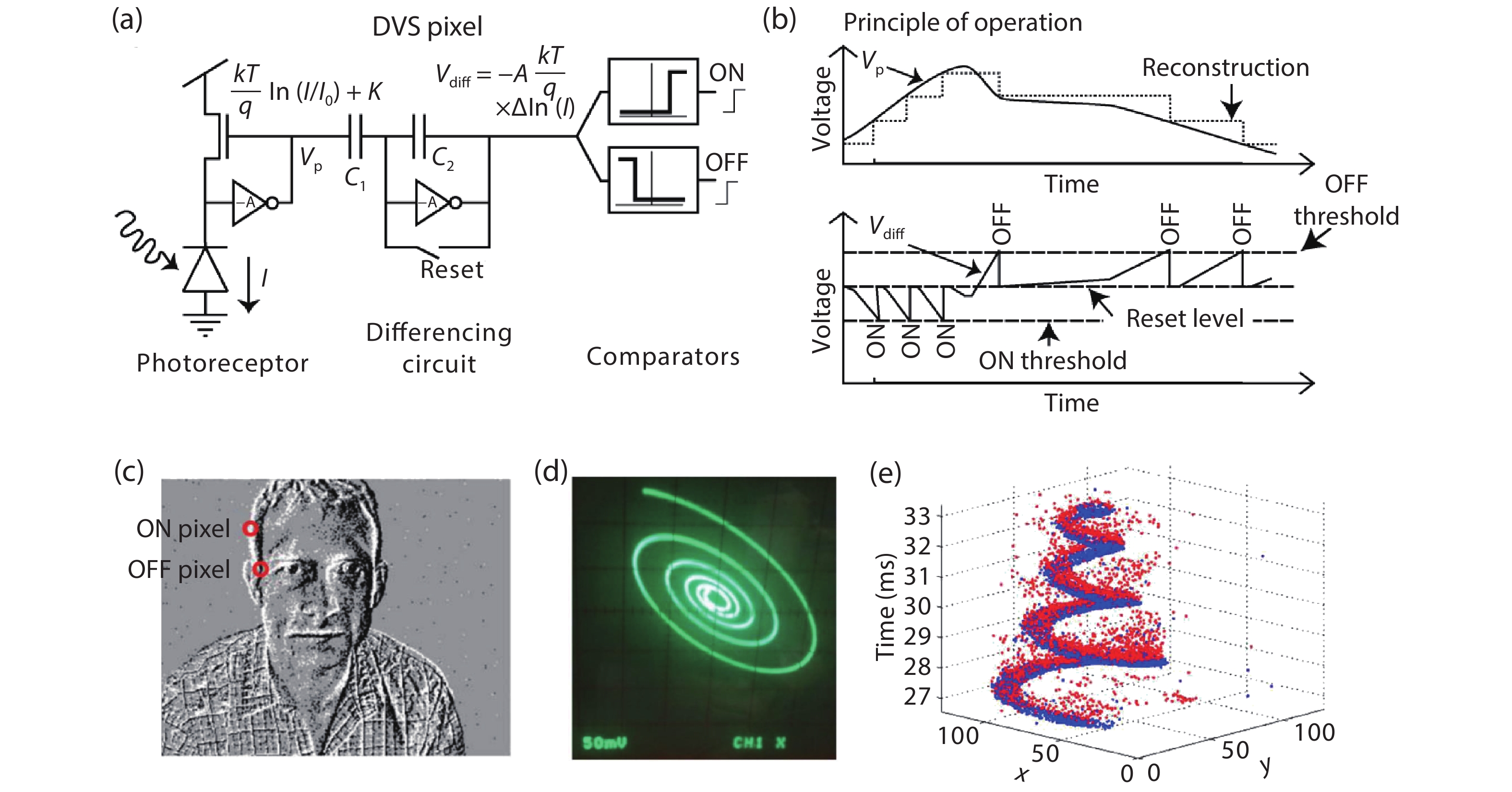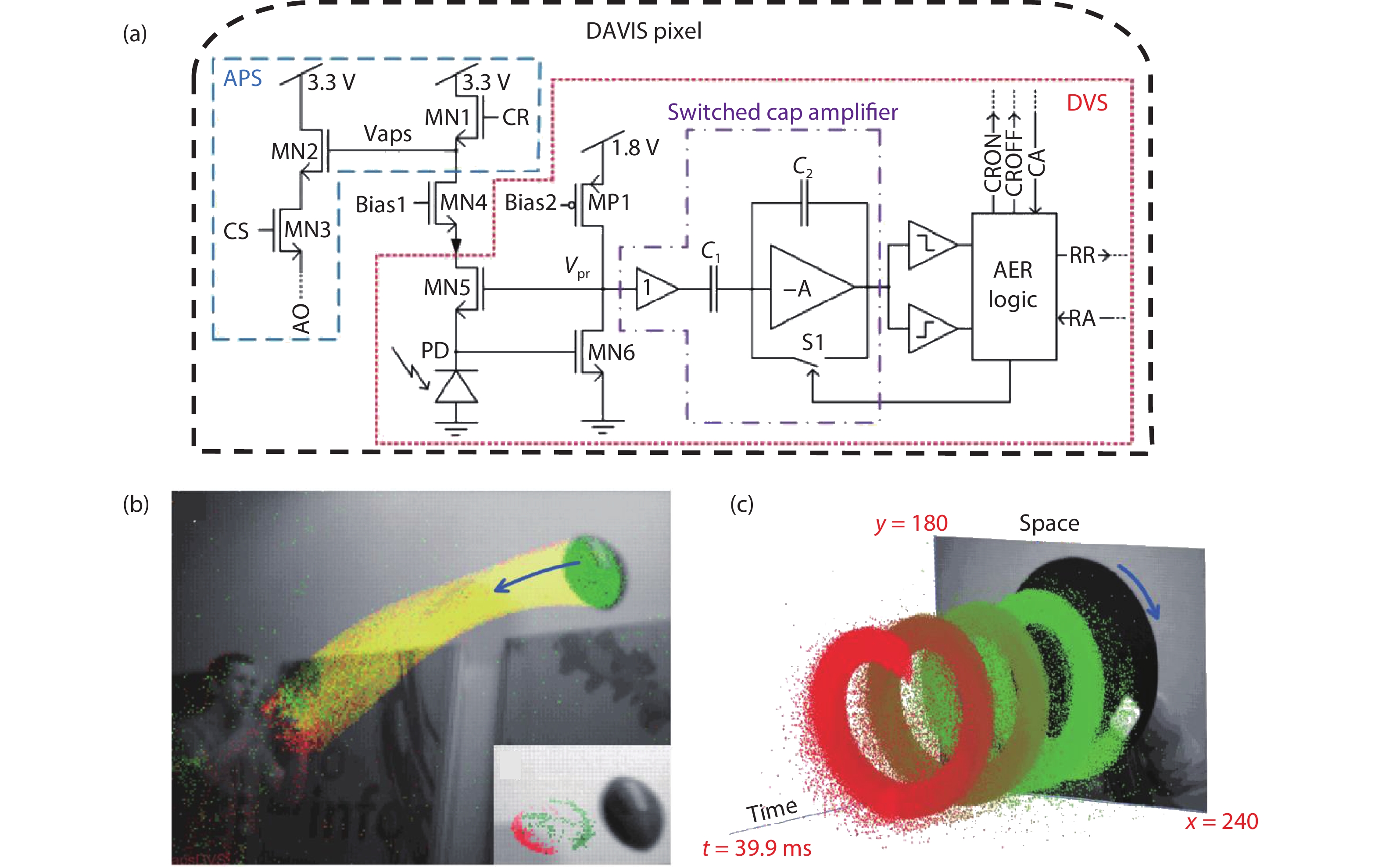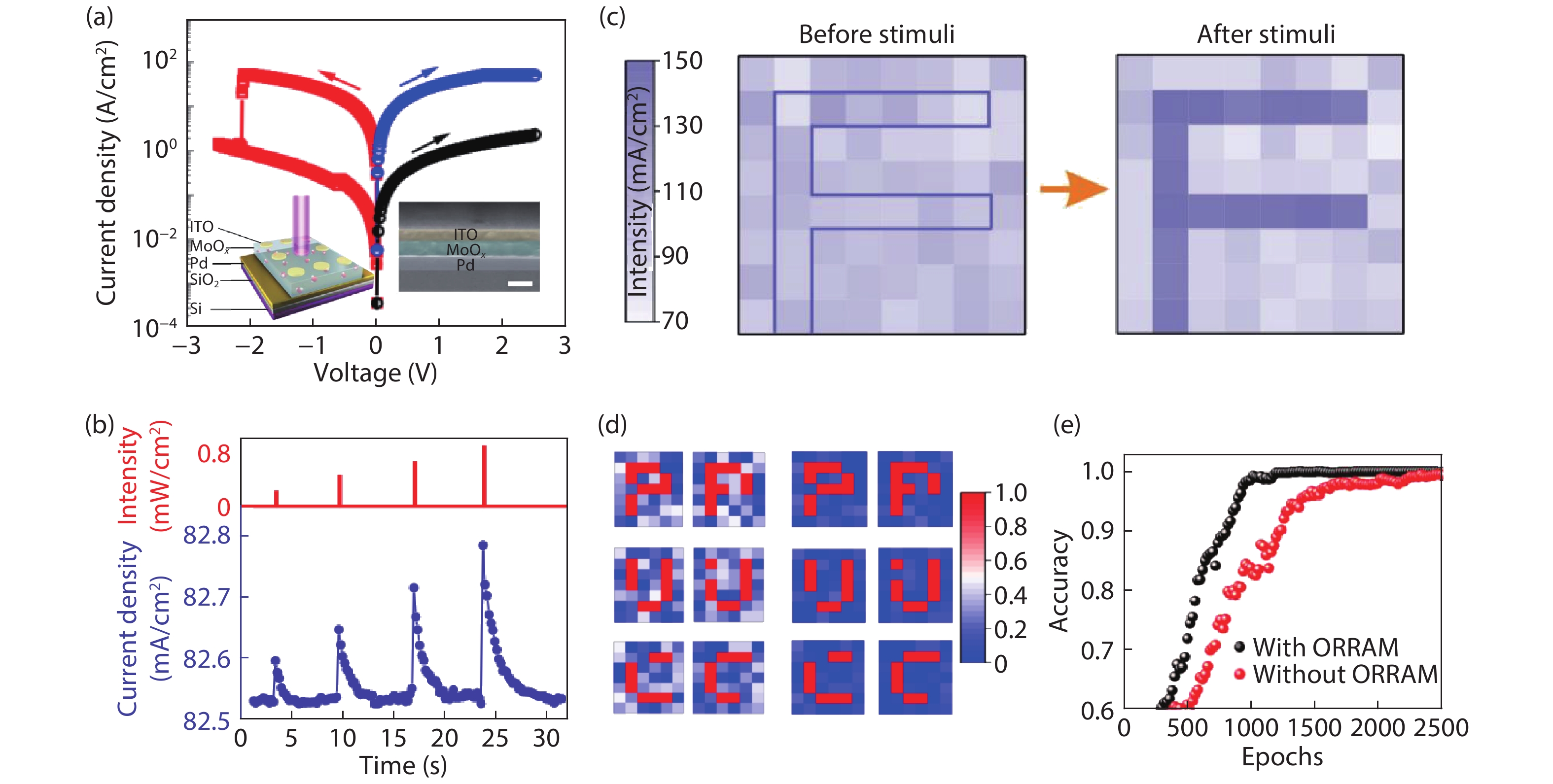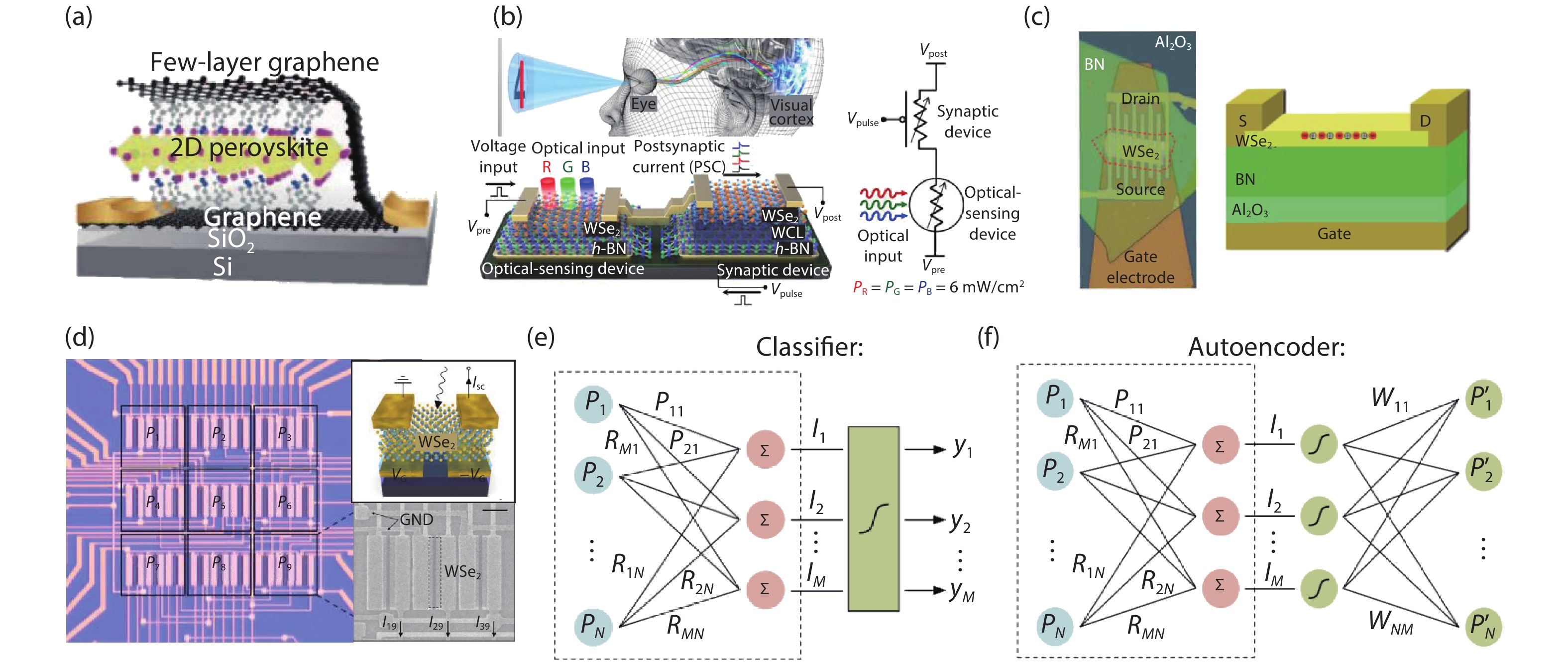| Citation: |
Fuyou Liao, Feichi Zhou, Yang Chai. Neuromorphic vision sensors: Principle, progress and perspectives[J]. Journal of Semiconductors, 2021, 42(1): 013105. doi: 10.1088/1674-4926/42/1/013105
****
F Y Liao, F C Zhou, Y Chai, Neuromorphic vision sensors: Principle, progress and perspectives[J]. J. Semicond., 2021, 42(1): 013105. doi: 10.1088/1674-4926/42/1/013105.
|
Neuromorphic vision sensors: Principle, progress and perspectives
DOI: 10.1088/1674-4926/42/1/013105
More Information
-
Abstract
Conventional frame-based image sensors suffer greatly from high energy consumption and latency. Mimicking neurobiological structures and functionalities of the retina provides a promising way to build a neuromorphic vision sensor with highly efficient image processing. In this review article, we will start with a brief introduction to explain the working mechanism and the challenges of conventional frame-based image sensors, and introduce the structure and functions of biological retina. In the main section, we will overview recent developments in neuromorphic vision sensors, including the silicon retina based on conventional Si CMOS digital technologies, and the neuromorphic vision sensors with the implementation of emerging devices. Finally, we will provide a brief outline of the prospects and outlook for the development of this field. -
References
[1] McCulloch W S, Pitts W. A logical calculus of the ideas immanent in nervous activity. Bull Math Biophys, 1943, 5(4), 115 doi: 10.1007/BF02478259[2] Hebb D O. The organization of behavior: a neuropsychological theory. J Wiley; Chapman & Hall, 1949[3] Carver M. Analog VLSI and neural systems. Addison-Wesley, 1989[4] Maher M A C, Deweerth S P, Mahowald M A, et al. Implementing neural architectures using analog VLSI circuits. IEEE Trans Circuits Syst, 1989, 36(5), 643 doi: 10.1109/31.31311[5] Mead C. Neuromorphic electronic systems. Proc IEEE, 1990, 78(10), 1629 doi: 10.1109/5.58356[6] Hodgkin A L, Huxley A F. A quantitative description of membrane current and its application to conduction and excitation in nerve. J Physiol, 1952, 117(4), 500 doi: 10.1113/jphysiol.1952.sp004764[7] Merolla P A, Arthur J V, Alvarez-Icaza R, et al. A million spiking-neuron integrated circuit with a scalable communication network and interface. Science, 2014, 345(6197), 668 doi: 10.1126/science.1254642[8] Zidan M A, Strachan J P, Lu W D. The future of electronics based on memristive systems. Nat Electron, 2018, 1(1), 22 doi: 10.1038/s41928-017-0006-8[9] Wang C Y, Wang C, Meng F, et al. 2D layered materials for memristive and neuromorphic applications. Adv Electron Mater, 2019, 6(2), 1901107 doi: 10.1002/aelm.201901107[10] Tuma T, Pantazi A, Le Gallo M, et al. Stochastic phase-change neurons. Nat Nanotechnol, 2016, 11(8), 693 doi: 10.1038/nnano.2016.70[11] Kuzum D, Jeyasingh R G D, Lee B, et al. Nanoelectronic programmable synapses based on phase change materials for brain-inspired computing. Nano Lett, 2012, 12(5), 2179 doi: 10.1021/nl201040y[12] Yang C S, Shang D S, Liu N, et al. A synaptic transistor based on quasi-2D molybdenum oxide. Adv Mater, 2017, 29(27), 1700906 doi: 10.1002/adma.201700906[13] Tian H, Guo Q, Xie Y, et al. Anisotropic black phosphorus synaptic device for neuromorphic applications. Adv Mater, 2016, 28(25), 4991 doi: 10.1002/adma.201600166[14] Takeo O, Tsuyoshi H, Tohru T, et al. Short-term plasticity and long-term potentiation mimicked in single inorganic synapses. Nat Mater, 2011, 10(8), 591 doi: 10.1038/nmat3054[15] Posch C, Serrano-Gotarredona T, Linares-Barranco B, et al. Retinomorphic event-based vision sensors: bioinspired cameras with spiking output. Proc IEEE, 2014, 102(10), 1470 doi: 10.1109/JPROC.2014.2346153[16] Steffen L, Reichard D, Weinland J, et al. Neuromorphic stereo vision: A survey of bio-inspired sensors and algorithms. Front Neurorobot, 2019, 13, 28 doi: 10.3389/fnbot.2019.00028[17] Zhou F, Zhou Z, Chen J, et al. Optoelectronic resistive random access memory for neuromorphic vision sensors. Nat Nanotechnol, 2019, 14(8), 776 doi: 10.1038/s41565-019-0501-3[18] Mennel L, Symonowicz J, Wachter S, et al. Ultrafast machine vision with 2D material neural network image sensors. Nature, 2020, 579(7797), 62 doi: 10.1038/s41586-020-2038-x[19] Wang C Y, Liang S J, Wang S, et al. Gate-tunable van der Waals heterostructure for reconfigurable neural network vision sensor. Sci Adv, 2020, 6(26), eaba6173 doi: 10.1126/sciadv.aba6173[20] Seo S, Jo S H, Kim S, et al. Artificial optic-neural synapse for colored and color-mixed pattern recognition. Nat Commun, 2018, 9(1), 1 doi: 10.1038/s41467-017-02088-w[21] Tian H, Wang X, Wu F, et al. High performance 2D perovskite/ graphene optical synapses as artificial eyes. 2018 IEEE International Electron Devices Meeting (IEDM), 2018, 38.6.1[22] Choi C, Choi M K, Liu S, et al. Human eye-inspired soft optoelectronic device using high-density MoS2-graphene curved image sensor array. Nat Commun, 2017, 8(1), 1 doi: 10.1038/s41467-016-0009-6[23] Gu L, Poddar S, Lin Y, et al. A biomimetic eye with a hemispherical perovskite nanowire array retina. Nature, 2020, 581(7808), 278 doi: 10.1038/s41586-020-2285-x[24] Boyle W S, Smith G E. Charge coupled semiconductor devices. Bell Syst Tech J, 1970, 49(4), 587 doi: 10.1002/j.1538-7305.1970.tb01790.x[25] Theuwissen A J. Solid-state imaging with charge-coupled devices. Springer Science & Business Media, 2006[26] Taylor S A. CCD and CMOS imaging array technologies: technology review. UK: Xerox Research Centre Europe, 1998[27] Bigas M, Cabruja E, Forest J, et al. Review of CMOS image sensors. Microelectron J, 2006, 37(5), 433 doi: 10.1016/j.mejo.2005.07.002[28] Kim Y, Chortos A, Xu W, et al. A bioinspired flexible organic artificial afferent nerve. Science, 2018, 360(6392), 998 doi: 10.1126/science.aao0098[29] Lee G J, Choi C, Kim D H, et al. Bioinspired artificial eyes: Optic components, digital cameras, and visual prostheses. Adv Funct Mater, 2017, 28(24), 1705202 doi: 10.1002/adfm.201705202[30] Song Y M, Xie Y, Malyarchuk V, et al. Digital cameras with designs inspired by the arthropod eye. Nature, 2013, 497(7447), 95 doi: 10.1038/nature12083[31] Jeong K H, Kim J, Lee L P. Biologically inspired artificial compound eyes. Science, 2006, 312(5773), 557 doi: 10.1126/science.1123053[32] Ko H C, Stoykovich M P, Song J, et al. A hemispherical electronic eye camera based on compressible silicon optoelectronics. Nature, 2008, 454(7205), 748 doi: 10.1038/nature07113[33] Posch C. Bio-inspired vision. J Instru, 2012, 7(01), C01054 doi: 10.1088/1748-0221/7/01/C01054[34] Gollisch T, Meister M. Eye smarter than scientists believed: Neural computations in circuits of the retina. Neuron, 2010, 65(2), 150 doi: 10.1016/j.neuron.2009.12.009[35] Masland R H. The fundamental plan of the retina. Nat Neurosci, 2001, 4(9), 877 doi: 10.1038/nn0901-877[36] Rodieck R W, Rodieck R W. The first steps in seeing. Sunderland, MA: Sinauer Associates, 1998[37] Cho D D, Lee T. A review of bioinspired vision sensors and their applications. Sens Mater, 2015, 27(6), 447 doi: 10.18494/SAM.2015.1083[38] Pereda A E. Electrical synapses and their functional interactions with chemical synapses. Nat Rev Neurosci, 2014, 15(4), 250 doi: 10.1038/nrn3708[39] Tan Z H, Yang R, Terabe K, et al. Synaptic metaplasticity realized in oxide memristive devices. Adv Mater, 2016, 28(2), 377 doi: 10.1002/adma.201503575[40] Yu H, Gong J, Wei H, et al. Mixed-halide perovskite for ultrasensitive two-terminal artificial synaptic devices. Mater Chem Front, 2019, 3(5), 941 doi: 10.1039/C9QM00061E[41] Etienne-Cummings R, Van der Spiegel J. Neuromorphic vision sensors. Sens Actuators A, 1996, 56(1/2), 19 doi: 10.1016/0924-4247(96)01277-0[42] Indiveri G, Douglas R. Neuromorphic vision sensors. Science, 2000, 288(5469), 1189 doi: 10.1126/science.288.5469.1189[43] Moini A. Vision chips. Springer Science & Business Media, 1999[44] Lichtsteiner P, Posch C, Delbruck T. A 128 × 128 120 db 30 mW asynchronous vision sensor that responds to relative intensity change. 2006 IEEE International Solid State Circuits Conference – Digest of Technical Papers, 2006, 2060[45] Lichtsteiner P, Posch C, Delbruck T. A 128 × 128 120 dB 15 μs latency asynchronous temporal contrast vision sensor. IEEE J Solid-State Circuits, 2008, 43(2), 566 doi: 10.1109/JSSC.2007.914337[46] Leñero-Bardallo J A, Serrano-Gotarredona T, Linares-Barranco B. A 3.6 μs latency asynchronous frame-free event-driven dynamic-vision-sensor. IEEE J Solid-State Circuits, 2011, 46(6), 1443 doi: 10.1109/JSSC.2011.2118490[47] Posch C, Matolin D, Wohlgenannt R. A QVGA 143 dB dynamic range frame-free pwm image sensor with lossless pixel-level video compression and time-domain CDS. IEEE J Solid-State Circuits, 2011, 46(1), 259 doi: 10.1109/JSSC.2010.2085952[48] Posch C, Matolin D, Wohlgenannt R. A QVGA 143dB dynamic range asynchronous address-event PWM dynamic image sensor with lossless pixel-level video compression. 2010 IEEE International Solid-State Circuits Conference (ISSCC), 2010, 400[49] Berner R, Brandli C, Yang M, et al. A 240 × 180 10 mW 12 μs latency sparse-output vision sensor for mobile applications. 2013 Symposium on VLSI Circuits, 2013, C186[50] Brandli C, Berner R, Yang M, et al. A 240 × 180 130 dB 3 μs latency global shutter spatiotemporal vision sensor. IEEE J Solid-State Circuits, 2014, 49(10), 2333 doi: 10.1109/JSSC.2014.2342715[51] Lichtsteiner P, Delbruck T. A 64 × 64 AER logarithmic temporal derivative silicon retina. Research in Microelectronics and Electronics, 2005 PhD, 2005, 2, 202 doi: 10.1109/RME.2005.1542972[52] Zhou F, Liu Y, Shen X, et al. Low-voltage, optoelectronic CH3NH3PbI3– xCl x memory with integrated sensing and logic operations. Adv Funct Mater, 2018, 28(15), 1800080 doi: 10.1002/adfm.201800080[53] Lei S, Wen F, Li B, et al. Optoelectronic memory using two-dimensional materials. Nano Lett, 2015, 15(1), 259 doi: 10.1021/nl503505f[54] Lee J, Pak S, Lee Y W, et al. Monolayer optical memory cells based on artificial trap-mediated charge storage and release. Nat Commu, 2017, 8(1), 14734 doi: 10.1038/ncomms14734[55] Lee D, Hwang E, Lee Y, et al. Multibit MoS2 photoelectronic memory with ultrahigh sensitivity. Adv Mater, 2016, 28(41), 9196 doi: 10.1002/adma.201603571[56] Lipatov A, Sharma P, Gruverman A, et al. Optoelectrical molybdenum disulfide (MoS2)-ferroelectric memories. ACS Nano, 2015, 9(8), 8089 doi: 10.1021/acsnano.5b02078[57] Roy K, Padmanabhan M, Goswami S, et al. Graphene–MoS2 hybrid structures for multifunctional photoresponsive memory devices. Nat Nanotechnol, 2013, 8(11), 826 doi: 10.1038/nnano.2013.206[58] Xiang D, Liu T, Xu J, et al. Two-dimensional multibit optoelectronic memory with broadband spectrum distinction. Nat Commun, 2018, 9(1), 2966 doi: 10.1038/s41467-018-05397-w[59] Qin S, Wang F, Liu Y, et al. A light-stimulated synaptic device based on graphene hybrid phototransistor. 2D Mater, 2017, 4(3), 035022 doi: 10.1088/2053-1583/aa805e[60] Ni Z, Wang Y, Liu L, et al. Hybrid structure of silicon nanocrystals and 2D WSe2 for broadband optoelectronic synaptic devices. 2018 IEEE International Electron Devices Meeting (IEDM), 2018, 38.5.1[61] Wang W, Panin G N, Fu X, et al. MoS2 memristor with photoresistive switching. Sci Rep, 2016, 6(1), 31224 doi: 10.1038/srep31224[62] Tran M D, Kim H, Kim J S, et al. Two-terminal multibit optical memory via van der Waals heterostructure. Adv Mater, 2019, 31(7), 1807075 doi: 10.1002/adma.201807075[63] Hu L, Yuan J, Ren Y, et al. Phosphorene/ZnO nano-heterojunctions for broadband photonic nonvolatile memory applications. Adv Mater, 2018, 30(30), 1801232 doi: 10.1002/adma.201801232[64] Zhou F, Chen J, Tao X, et al. 2D materials based optoelectronic memory: Convergence of electronic memory and optical sensor. Research, 2019, 2019, 9490413 doi: 10.34133/2019/9490413[65] Chai Y. In-sensor computing for machine vision. Nature, 2020, 579, 32 doi: 10.1038/d41586-020-00592-6[66] Zhang K, Jung Y H, Mikael S, et al. Origami silicon optoelectronics for hemispherical electronic eye systems. Nat Commun, 2017, 8(1), 1782 doi: 10.1038/s41467-017-01926-1[67] Laughlin S B, van Steveninck R R R, Anderson J C. The metabolic cost of neural information. Nat Neurosci, 1998, 1(1), 36 doi: 10.1038/236 -
Proportional views






 DownLoad:
DownLoad:




















